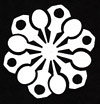
Russian-born artist Wassily Kandinsky is credited with the first completely abstract painting, in 1910; he co-founded the avant-garde art collective "The Blue Rider" in Munich in 1911; he was a faculty member of the incredibly influential Bauhaus School from 1922 until its dissolution by the Nazis in 1933; and after that settled in France (Neuilly, near Paris), where among the many visitors to his studio was Joan Miro. Kandinsky and Miro created a visual vocabulary of abstraction that continues unabated today. While Miro's abstract figures look organic, i.e. like living beings, Kandinsky, after working through a progression of styles, ended up with figures that look mechanical, or at least machine-made. "New wave" design of the 1980s owes more than a little debt to Kandinsky's explorations of geometric forms. This tie from the Gallery Collection by Christina Desiree is entitled "Kandinsky -- Black Welft". I can't find a painting with that title; this could be a cross between "Black and Violet" and any one of Kandinsky's later "Compositions" (or "Constructions"). Kandinsky was especially smitten with the circle, of which he wrote:
“The circle is the synthesis of the greatest oppositions. It combines the concentric and the eccentric in a single form and in equilibrium. Of the three primary forms, it points most clearly to the fourth dimension.”
Perhaps he is right; many of my favorite tie designs are composed solely of circles, and will be posted here in weeks to come.
About Christina Desiree I know nothing except that the Gallery Collection of neckties is uniformly excellent; they are a little more lively than the ties made by the major force in art reproduction ties, Boxelder of Milwaukee, but are more difficult to find.

No comments:
Post a Comment